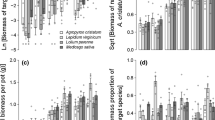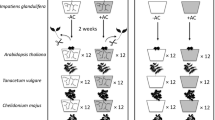Abstract
Paspalum paspalodes, an introduced grass species, and Aeluropus littoralis, an indigenous species, develop abundantly in seasonally-flooded marshes in the Camargue (Rhône Delta, France). Although they occur together in many multispecies communities, neither species occurs when the other is dominat. The cultivation of cuttings of P. paspalodes and A. littoralis in a replacement series in a combination of five proportions (0/100, 25/75, 50/50, 75/25 and 100/0) and four salinities (0,2 4, and 6 g Cl- · 1-1) gave contrasting results for the two species: (1) strong asymmetrical competition in favour of P. paspalodes at 0 g Cl- · 1-1, (2) no significant effect of salinity on the mean above-ground and underground yields per plant for A. littoralis over the range tested, (3) a major decrease in the mean above-ground and belowground yields per plant for P. paspalodes with increasing salinity, (4) a reversal of the competitive balance between the species with increasing salinity. The cultivation of cuttings at high temperatures in a greenhouse in a combination of the same five proportions at two salinities (0 and 4 g Cl- · 1-1) refuted the hypothesis that the introduced species is better adapted to summer temperatures. Because it is not salt-tolerant, P. paspalodes cannot be considered as a potentially invasive species in the Camargue. Its abundance depends on newly created and artificially maintained habitats.
Similar content being viewed by others
References
Ashman H (1973) Man's impact on the several regions with Mediterranean climates. In: Castri F di, Mooney HA (eds) Mediterranean type ecosystems-origins and structure. Springer Berlin Heidelberg New York pp 363–390
Austin MP (1982) Use of a relative physiological performance value in the prediction of performance in multispecies mixtures from monoculture performance. J Ecol 70:559–570
Barbero M, Loisel R, Quézel P (1984) Incidences des pratiques culturales sur la flore et la végétation des agrosystèmes en région méditerranéenne. CR Soc Biogéogr 59 (4):463–473
Barclay AM, Crawford RMM (1982) Plant growth and survival under strict anaerobiosis. J Exp Bot 33:541–549
Bleken E (1983) New ghosts of competition: Reply to Connell. Oikos 41:289–290
Connell JH (1983a) Interpreting the results of field experiments: Effect of indirect interactions. Oikos 41:290–291
Connell JH (1983b) On the prevalence and relative importance of interspecific competition: Evidence from field experiments. Am Nat 22:661–696
Connell JH (1990) Apparent versus “real” competition in plants. In: Grace JB, Tilman D (eds) Perspectives on plant competition. Academic Press, Inc. San Diego, pp 9–26
Connolly J (1986) On difficulties with replacement series methodology in mixture experiments. J Appl Ecol 23:125–137
Corre JJ (1975) Etude phyto-écologique des milieux littoraux en Languedoc et en Camargue. Thesis USTL Montpellier
Elton CS (1958) The ecology of invasions of animals and plants. Methuen London
Firbank LG, Watkinson AR (1986) Modelling the population dynamics of an arable weed and its effect upon crop yield. J Appl Ecol 23:147–159
Fox MD, Fox BJ (1986) Resilience of animal and plant communities to human disturbance. In: Dell RL, Hopkins AJM, Lamont BB (eds) Resilience in Mediterranean-type ecosystems. Dr. W. Junk Publishers Dordrecht, pp 39–64
Gill GJ (1970) The flooding tolerance of woody species. A review. Forestry Abstracts 31:671–688
Grace JB, Wetzel RG (1981) Habitat partitioning and competitive displacement in cattails (Typha): experimental field studies. Am Nat 118:463–474s
Grime JP, Hodgson JG (1987) Botanical contributions to contemporary ecological theory. In: Rorison IH, Grime JP, Hunt R, Hendry GAF, Lewis DH (eds), Frontiers of comparative plant ecology. New phytol 106 (supplement), Academie Press London, pp 283–286
Gros P, Grillas P (1990) Un nouveau mode de gestion des friches rizicoles: le marais artificiel. Courrier PNRC Camargue 35, pp 39–44
Guillerm JL, Le Floc'h E, Maillet J, Boulet C (1990) The invading weeds within the Western Mediterranean Basin. In: Castri F di, Hansen AJ, Debussche M (eds) Biological invasions in Europe and the Mediterranean basin. Kluwer Academic Press Dordrecht, pp 61–84
Harper JL (1977) Population biology of plants, Academic press London
Holliday R (1960) Plant population and crop yield. Nature 186:22–24
Hsiao AI, Huang WZ (1989a) Effects of flooding on rooting and sprouting of isolated stem segments and on plant growth of Paspalum distichum L. Weed Res 29:335–344
Hsiao AI, Huang WZ (1989b) Apical dominance in the shoot and its possible rôle in the survival of Paspalum dischum L. Weed Res 29:327–334
Keddy PA (1989) Competition Population and community biology series. Chapman and Hall London
Keddy PA, Shipley B (1989) Competitive hierarchies in plant communities. Oikos 54:234–241
Kosinova J (1974) Studies on the weed flora of cultivated lands in Egypt. 4. Mediterranean an Tropical elements. Candollea 29:281–295
Kozlowski TT, Pallardy SG (1984) Responses of woody plants to flooding. In: Kozlowski TT (ed) Flooding and plant growth. Academic Press Inc Orlando, pp 129–159
Jaeger RG (1971) Competitive exclusion as a factor influencing the distributions of two species of terrestrial salamanders. Ecology 52:632–637
Le Houréou HN (1981) Impact of man and his animals on Mediterranean vegetation. In: di Castri F, Goodall DW, Specht RDL (eds) Mediterranean type shrublands (Ecosytems of the World. vol 11) Elsevier Amsterdam, pp 479–521
Bumaret R, Guillerm JL, Delay J, Ait Lhaj Loutfi A, Izco J, Jay M (1987) Polyploidy and habitat differenciation in Dactylis glomerata L. from Galicia (Spain). Oecologia 73:436–446
Marquardt DW (1963) An algorithm for least-squares estimation of nonlinear parameters. J Soc Ind Appl Math 11(2):431–441
Mesléard F, Grillas P, Lepart J (1991) Plant community succession in a coastal wetland after abandonment of cultivation: the example of the Rhône delta. Vegetatio 94:35–45
Molinier R, Tallon G (1970) Prodrome des unités phyto-sociologiques observées en Camargue. Bull Mus Hist Nat Marseille 30:5–110
Molinier R, Tallon G (1974) Documents pour un inventaire des plantes vasculaires de la Camargue. Bull Mus Hist Nat Marseille 34:7–165
Mooney HA, Drake IA (eds) (1986) Biological invasions of North America and Hawai, Springer Berlin Heidelberg New York
Pearey RW, Tumosa N, Williams K (1981) Relationship between growth, photosynthesis and competitive interactions for a C3 and C4 plant. Oecologia 48:371–376
Pignatti S (1983) Human impact on the vegetation of the Mediterranean Basin. In: Holzner W, Werger MJA, Ikusima (eds). Man's impact on vegetation, Junk Publishers The Hague, pp 55–61
Pirot JY, Chessel D, Tamisier A (1984) Exploitation alimentaire des zones humides de Camargue par cinq espèces de canards de surface en hivernage et en transit: modélisation spatiotemporelle. Revue d'Ecologie (Terre et Vie) 39:167–193
Quezel P, Barbero M, Bonin G, Loisel R (1990) Recent invasions around the Mediterranean Basin. In: Castri F di, Hansen AJ, Debussche M (eds), Biological invasions in Europe and the Meditérranean basin, Kluwer Academic Press Dordrecht, pp 51–60
Rejmanek M, Robinson GR, Rejmankova E (1989) Weed-Crop Competition: Experimental designs and models for data analysis. Weed Science 37:276–284
Rozema J, Scholten MCT, Blaauw PA, Diggelen J (1988) Distribution limits and Physiological tolerances with particular reference to the salt marsh environment. In: Davy AJ, Hutchings MJ, Watkinson AR (eds) Plant population ecology. Blackwell, Oxford, pp 137–164
Rumpho ME, Kennedy RA (1981) Anaerobic metabolism in germinating seeds of Echinochloa crus-galli (barnayard grass). Metabolite and enzyme studies. Plant Physiol 68:165–168
Saxena KG, Ramakrishnan PS (1984) C3/C4 species distribution among successional herbs following slah and burn in northeastern India. Acta Oecol Oecol Plant 3:335–346
Shomer-Ilan A, Waisel Y (1973) The influence of sodium on the balance between the C3-and C4-carbon fixation pathways. Physiol Plant 29:190–193
Silander JA, Antonovics J (1982) Analysis of interspecific interactions in a coastal plant community—a perturbation approach. Nature 298:557–560
Snow AA, Vince SW (1984) Plant zonation in an Alaskan salt marsh II An experimental study of the role of edaphic conditions. J Ecol 72:669–684
Spitters CJT (1983) An alternative approach to the analysis of mixed cropping experiments. I. Estimation of competition effects. Neth J Agr Sci 31:1–11
Suehiro K, Ogawa H (1980) Competition between two annual herbs, Atriplex gmelini C. A. Mey and Chenopodium album L., in mixed cultures irrigated with seawater of various concentrations. Oecologia 45:167–177
Tallon, G (1958) La flore des rizières de la région d'Arles et ses répercussions sur la culture du riz. Vegetatio 7(1):20–42
Tilman D (1987a) On the mechanisms of competition and the mechanisms of competitive superiority. Functional Ecology 1:769–774
Tilman D (1987b) The importance of the mechanisms of interspecific competition. Am Nat 129:304–315
Tutin TG, Heywwood VH, Burges NA, Moore DM, Valentine DH, Walters SM, Webb DA (1964–1980) Flora Europaea. Cambridge Univ. Press Cambridge
Waisel Y (1972) Biology of halophytes. Academic Press New York
Watkinson AR (1980) Density-dependence in single-species populations of plants. J Theor Biol 83:345–357
Watkinson AR (1981) Interference in pure and mixed population of Agrostemna githago J Appl Ecol 18:967–976
Wit CT de (1960) On competition. Agr Res Rep Verl Landbouk Onderz 66:1–82
Zohary M (1983) Man and vegetation in the middle East. In: Holzner W, Werger MJA, Ikusima I (eds) Man's impact on vegetation, Junk Publishers The Hague, pp 55–61
Author information
Authors and Affiliations
Rights and permissions
About this article
Cite this article
Mesléard, F., Ham, L.T., Boy, V. et al. Competition between an introduced and an indigenous species: the case of Paspalum paspalodes (Michx) Schribner and Aeluropus littoralis (Gouan) in the Camargue (southern France). Oecologia 94, 204–209 (1993). https://doi.org/10.1007/BF00341318
Received:
Accepted:
Issue Date:
DOI: https://doi.org/10.1007/BF00341318




